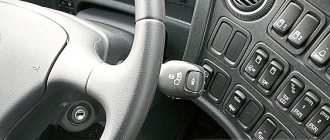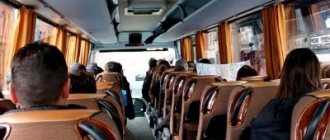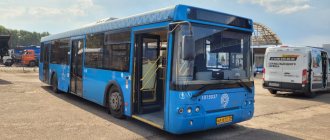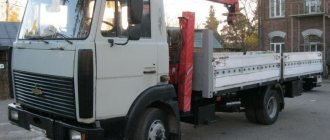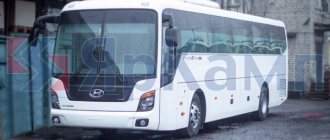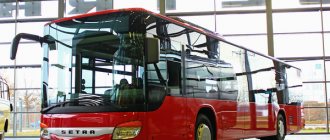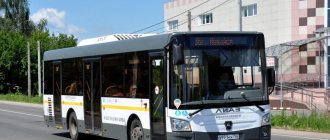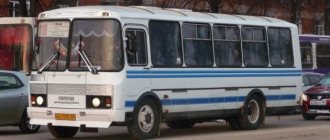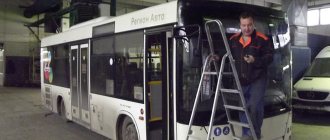Setra MultiClass buses: S 415 LE business and S 418 LE business. Setra Photos
Setra Omnibusse is one of the leading companies in Germany in the field of bus construction. The manufacturer produces and sells passenger vehicles under the world-famous Setra brand. The company's equipment is in demand in the domestic market and abroad. Buses with different technical characteristics roll off the production line of the enterprise. To simplify the process of searching, selecting and purchasing equipment, this article presents the types of Setra buses in accordance with various parameters that arouse the greatest interest of Internet users, and offers technical characteristics of individual popular models.
Company history and brand features
The history of SETRA buses dates back to 1911. The company was founded by Karl Kassbohrer, which was reflected in the design of the cars: until 1983, a large metal letter “K” was displayed in the center of the radiator grille. It is still present, but made of plastic, shifted to the right and located under the SETRA inscription.
The brand name SETRA is an abbreviation; this is how the main design feature of these buses is encrypted. Their body is self-supporting - SelbstRAgende, with a welded frame made of metal angles. The first model of this design, SETRA S8, appeared on German roads in 1951.
The layout of the power units was made according to a “pushing” scheme - the engine is in the aft compartment. It did not change in subsequent years, except in those cases when the vehicle body was made of a composite one - the SG series of articulated city buses. Since 1994, the company has been part of the Daimler AG concern.
In the European ranking table, the SETRA brand is among the top ten manufacturers of luxury tourist and intercity models. However, the range of cars it produces is much wider. It also includes medium-comfort intercity buses (MD series), as well as regular buses operating on municipal routes - SL series.
Double-decker Setra S 431 DT (6×2)
A centralized air conditioning system provides a favorable climate on two floors. The climate control power is quite enough to cool or heat a fairly impressive enclosed space.
Individual lighting bulbs are provided in the ceiling installation near the ventilation grilles.
For an additional fee, energy-saving LED technology light bulbs can be installed in place of incandescent lamps. On the same panel there is a button to call a tour guide or accompanying person. There are three built-in LCD TVs in the salon. The image is transmitted to TVs from an on-board player or satellite repeater.
The toilet stall is located on the left side of the first floor. It has a 130 liter water tank. Nearby there is a reserve of 150 liters to ensure water supply for the kitchen. A drinking water tank with a capacity of 75 liters is located in the center of the cabin, to the left of the main exit.
There are two built-in staircases on board the double-decker bus: a spiral staircase and an L-shaped staircase. The height of the steps varies, which, according to the observations of technical specialists, will help the passenger not to stumble.
Photos of the bus interior
Layout of seats in the cabin
Video review of the Setra S 431 DT double-decker bus
Modern Setra models are ideally equipped for short and long distance travel. However, the model range of the two hundredth series is still in demand and is used in the Russian Federation and many other countries. Their advantage is considered to be a more reasonable price, as well as the fact that the bus was originally ideally designed for comfortable transportation.
The “200th” series is the constructive foundation of the brand
In 1976, Setra Omnibusse began mass production of “200 series” buses, the design and most of the design solutions of which form the basis of today’s model range. Externally, the cars were distinguished by the shape of the front end and a solid windshield. They were equipped with disc brakes and air suspension. The body with a welded spatial frame remains a signature feature of the brand.
The basis of the model range was the S200 model, presented in 1972 at the Geneva Motor Show. The car had a revolutionary one-and-a-half-story design, which made it possible to provide passengers with special comfortable options during a long journey. On its basis, the SETRA S215 HD models were built, as well as all cars with model indices HDH and HDS.
The “two hundred” edition consisted of the following set of models:
The number of seats in the cabin can be calculated, taking into account the numerical index of the model - after two comes the number of rows.
S 215HD
Series 400 and 500
The production of all models of the “200th” series was discontinued in 1997. It was replaced first by the “three hundredth”, and then by the 400 and 500 series.
- Buses of the 500 series are luxury tourist vehicles. They are divided into two classes: Top and Comfort. Among the first, there are not only traditional one-and-a-half-story (HDH index), but also two-story (DT). Representatives of the Comfort type are also divided into two subclasses - HD and MD, differing in height due to the size of the luggage compartment.
- Series 400 belongs to the Multi class. These are urban (type UL) and intercity one-and-a-half-story representatives of the brand of medium comfort (type H). SETRA Multiclass S415 cars are medium in passenger capacity and therefore the most common. They have 15 rows of seats and 53 seats.
The seat layout of the 400 model is shown in the figure below.
Dimensions and number of seats in the new buses:
Model description
Long-distance transport is usually equipped with softer seats and armrests, and it also becomes possible to transport large cargo. Setra is a leader in the tourist bus industry. During the development of models, exclusively modern technical developments are used, high standards are maintained in ensuring safety and convenience during long trips.
Setra buses are the brainchild of Setra Omnibusse. The company produces tourist, intercity and urban types of transport of various levels of capacity and comfort.
Setra has a lot of advantages over its competitors, some of which are worth paying attention to:
In addition, it is worth noting that Setra is continuously improving its production, which means the product offered is becoming higher quality.
Bus Setra 215 HD
The Setra 215 HD model is still considered a constant favorite and sales leader to this day.
Photos of the salon
Location of seats on the bus
The salon is equipped with a high-quality climate control system, which helps maintain favorable temperature conditions at any time of the year. Independent ventilation control is installed above each passenger and driver's seat. In addition, the cabin has a video-sound system, complemented by a TV.
Orthopedic seats that independently adjust to the passenger’s personal preferences. Thanks to this, even during a fairly long trip your back will not swell. Additionally, there is a special retractable footrest that allows you to comfortably position your feet.
Video review of the Setra 215 HD bus
External parameters
Before we begin to analyze the characteristics of Setra buses, one interesting feature should be noted. The equipment markings, consisting of letters and numbers, encode some information about each model. The numbers indicate the generation/series of the bus and the number of rows located in the cabin. The letter part provides information about the body type (there are only two options here - S (single) and SG (articulated) and configuration (in this case there are several options).
Tourist bus Setra S215HD. Photo Wikipedia
For example, the popular Setra S215HD model is a single-section bus for tourist and intercity trips with a luggage compartment located under the floor of the passenger compartment. With the introduction of the 400th series into production, equipment began to be divided into three classes: MultiClass, ComfortClass and TopClass.
dimensions
Buses of any brand (and Setra is no exception) can be divided into five classes in accordance with the overall dimensions of the body and interior capacity. Classification is carried out primarily based on the length of the structure. The width of most types of transport, with the exception of platform buses, is limited by transport standards, which are the same in each country. This figure should not exceed 2550 mm; Setra equipment fully meets all current requirements. The height of the German company's buses varies widely. The height of the smallest specimens is slightly more than 2500 mm, and the two-story giants are about 4000 mm.
Bus Setra S517HDH. Setra Photos
The model line of the German manufacturer at different times included small, medium, large and extra large options. The entire range of Setra vehicles is divided into equipment belonging to six generations or series, each of which had models of different types, including in accordance with dimensions. The marking of equipment provides an understanding that the smaller the number written in it, the fewer rows the passenger compartment is equipped with, and, accordingly, the more compact dimensions the body has. Currently (as of 2020) the company offers large and extra large models. For example, the three-axle one-and-a-half-story model for long-distance travel S517HDH has the following dimensions, LxWxH, mm. – 14165x2550x3880.
Capacity: 45, 49, 50, 53 and more
Capacity is one of the main criteria that potential buyers pay attention to when choosing. In most cases, the total capacity and number of seats depends on the length of the body . But in the Setra model line it is possible to find buses that, in accordance with body dimensions, belong to one class, and with capacity - to another. One of these models is the double-decker tourist Setra S328DT, which has the following parameters. Dimensions of 12000x2500x4000 allow us to characterize the bus as a representative of a large class. Since the bus is a tourist bus, the total capacity is equal to the number of seats and is 74 or 75 (depending on the configuration), which allows the model to be classified as a particularly large class.
Setra S328DT double decker bus. Photo Wikipedia
Internet users are especially interested in models with the following capacities:
- 45, Setra S213H fits this parameter;
- 49 – MultiClass S 415 LE business, Setra S415 GT-HD, TopClass S415HD;
- 50 – S215HD;
- 53 – MultiClass S 416 LE business, S140ES, S415 UL.
Modern Setra models can be equipped in various ways at the customer’s request, this also applies to the number of seats. The company offers models with the so-called “standard seat configuration”, as well as several other interior layout and layout options to choose from.
Seating chart, location of seats
The interior layout depends on the purpose of the bus. Different types of machines have their own individual characteristics:
- the interiors of urban models are equipped with a fairly small number of seats, a significant part of the area is left for wide aisles and storage areas;
- the interior layout of commuter cars depends on whether it is possible to transport standing passengers; if such an opportunity is provided, then the aisles are made wide, there are also storage areas, but small in size; if not, then the layout of the interior is almost similar to intercity models, in which chairs are arranged in even rows, with a narrow aisle between them;
- The layout of tourist buses is similar to that of intercity buses, but the various options and amenities that the “tourists” are equipped with make changes to the layout.
Interior diagrams of a double-decker TopClass S531DT bus. Setra Photos
The most unusual seating scheme is found in double-decker cars, used to solve various problems, designed for excursions and long trips, creating mobile homes, mobile clubs, restaurants, offices, etc. But even standard tourist double-deckers have an interesting interior layout. In double-decker Setra buses, on the first level there are comfortable boarding seats and a lift for a wheelchair or stroller, the interior layout resembles a typical intercity or tourist model, on the second level there is a toilet, seats for passengers with disabilities, as well as an empty area for the implementation of almost any ideas customer.
The company provides diagrams of all buses on sale. Customers are provided with basic layout options . The manufacturer is ready to fulfill various customer requirements and create an individually equipped bus.
Weight
The curb and technically permissible weight of the bus are mandatory characteristics. However, in open sources there are parameters of only some, and not all, Setra models. Average figures for different types of machines are about 10,000 and 20,000 kg. The Setra S208H small class has a curb weight of 5680 and a gross weight of 9700 kg.
Driver's seat
Setra buses are distinguished by a high level of comfort not only in the passenger compartment, but also in the driver’s seat. Models assembled over the years were equipped with a comfortable seat that ensured high-quality performance of duties, which guaranteed the safety of passengers and other road users. Intuitive and accessible, the instrument panel has always been a must-have element of the driver's seat. Depending on the model/modification, the cabin could be separated from the passenger compartment; a solid or partial partition was often absent.
The driver's seat in the Setra S415LE bus. Setra Photos
The driver's seat of modern models is distinguished by an exclusive design, tangible comfort, carefully thought-out ergonomics, attractive appearance, finishing made of high-quality materials, practicality, balance of all elements, cabin space, and the presence of specially equipped places for placing personal belongings. Modern models are equipped with a wide range of systems to ensure a high level of travel safety: ABS, ESP, ASR, active braking system, tire pressure monitoring and many others. The driver is given the opportunity to conveniently control all available functions, select parameters “for himself,” also focusing on the specifics of the trip, road surface, weather, etc.
The popular 400 series of Setra buses includes a number of bus lines, one of which is the 415. Offered in several modifications, different in purpose, the machines provide a high level of comfort for the driver, which is clearly presented in the photo of the cabin.
Equipment and additional options
The comfort and safety of Setra buses is confirmed by the rich basic equipment . Regardless of the type and model, the vehicle is equipped with all the options necessary in accordance with the standards, the number of which often exceeds customer expectations . Some additional options that can be equipped with this or that model are presented on the website. Potential owners will also be pleasantly surprised by the ability to choose a list of options.
Setra S517HDH bus interior. Setra Photos
Most models for long trips, including those from previous years of production, are equipped with comfortable adjustable seats, information and entertainment systems, a toilet, a kitchen unit with a washbasin, a coffee maker and a refrigerator, and air conditioning/climate control. The popular Setra 315 models were equipped with a wide range of amenities as standard.
Color solutions
The color schemes of the interior and body of buses cannot be fully attributed to technical characteristics, but decorative parameters often have a great impact on the choice of a potential buyer. That is why the manufacturer offers cars with bodies made in various colors and shades.
Bus Setra S140ES. Photo Wikipedia
There were models in the Setra line whose exterior successfully combined two, three or more colors , for example, the representative of the second generation, S140ES. Now the company prefers to produce cars whose bodies are painted in bright and rich colors: red, orange, blue, yellow, green. The range also includes standard white models.
Features and characteristics of Setra 215
The reliable Setra S 215 HD bus belongs to the Top Class series, that is, to the fourth generation of tourist liners. Buses captivate with their technical characteristics, affordable prices and high quality. The vehicles cover long distances with ease and are suitable for long-term use.
The bus, produced under the Setra brand, is equipped with a manual transmission, diesel engine and rear-wheel drive. The basic characteristics of the vehicle are as follows:
Setra buses are equipped with a Mercedes-Benz engine with a power of 256 horsepower. The working volume of the “heart” of this model is 12.76 liters, the number and arrangement of cylinders is 8V. The engine is located in the rear overhang.
The advantage of buying a Setra 215 is the wide selection of auto parts from different manufacturers. The most popular companies selling parts for buses are Vector, Sampa and Febi.
The total length of the bus is 12 meters; vehicles in the Comfort category are equipped with a microphone, audio and video system, toilet, and microphone. Additionally, you can install climate control, a refrigerator, a coffee machine, an air conditioner and other necessary elements.
The dynamic Setra bus has pneumatic brakes and Mercedes drums are installed in the front chassis. Users note a soft, pleasant and even quiet ride. The salon is quite convenient and comfortable. The ideal location of the seats is suitable for long transport. The seating positions can be adjusted and there are seat belts.
The bus presented by the Setra brand, the seating arrangement of which is made as comfortable as possible for passengers, has high-quality double-glazed windows, fold-out seats, and increased space between the rows of seats. Each tourist has individual lighting. The interior is made in velor.
Source
Examples of seat placement
The photo below shows the location of the seat on the bus. The layout of 47 seats is typical.
This scheme is typical for the following brands: Higer KLQ 6119 TQ, YUTONG 6129.
The next photo also shows the location of the seat on the bus (diagram). 49 seats is a fairly common option.
The scheme is typical for the following brands: Higer KLQ6129Q, Neoplan 1116 Bus, Setra 315.
Buses
Iveco Magelys (49 seats)
Bus
"Iveco Magelys" - tourist luxury! Luxury tourist bus. The bus is equipped with a kitchenette, refrigerator, and dry closet. The interior features plush upholstered comfortable soft reclining chairs with adjustable backrest and armrest. The bus has wide aisles and two LCD monitors for broadcasting video signals. Each seat is equipped with a guide call button and individual lighting. The tourist class bus “Iveco Magelys” is designed for traveling with maximum convenience both in Russia and abroad!
MAN Lion's Coach (R08) (57 seats)
Bus
MAN Lion's Coach (R07) (49 seats)
Bus
MAN luxury buses are good for both short trips and long excursions and transfers. "MAN" is a European quality standard! The buses have the right to travel abroad and are equipped with orthopedic seats - passengers will never have back pain. MAN buses are equipped with a modern multimedia system (DVD player, 2 TVs, sound system); orthopedic chairs with various adjustments; individual airflow; individual lighting; folding individual tables; toilet; mini kitchen. Ideal for business transportation, including sophisticated foreigners.
NEOPLAN Tourliner L P22 (49 seats)
Bus
NEOPLAN Cityliner P14 (49 seats)
Bus
Neoplan luxury buses are good for both short trips and long excursions and transfers. "Neoplan" is a European quality standard! The buses have the right to travel abroad and are equipped with orthopedic seats - passengers will never have back pain. Neoplan buses are equipped with a modern multimedia system (DVD player, 2 TVs, sound system); orthopedic chairs with various adjustments; individual airflow; individual lighting; folding individual tables; toilet; mini kitchen. Ideal for business transportation, including sophisticated foreigners.
KING LONG KLQ6129Q (49 seats)
Bus
The Higer bus is already a well-known new product made in China. The high level of build quality and rich basic equipment set Higer apart from other well-known bus brands. "Higer" is a modern bus that meets all the requirements of world standards. The “Higer” seats are soft and comfortable, with all the necessary adjustments: folding armrests, backrest tilt adjustment. Higer buses are equipped with a modern multimedia system (DVD player, TV, sound system), individual airflow, individual lighting, individual folding tables. The Higer bus is booked for excursions, business trips, and corporate events.
HIGER KLQ6129Q (49 seats)
Bus
The Higer bus is already a well-known new product made in China. The high level of build quality and rich basic equipment set Higer apart from other well-known bus brands. "Higer" is a modern bus that meets all the requirements of world standards. The “Higer” seats are soft and comfortable, with all the necessary adjustments: folding armrests, backrest tilt adjustment. Higer buses are equipped with a modern multimedia system (DVD player, TV, sound system), individual airflow, individual lighting. The Higer bus is booked for excursions, business trips, and corporate events.
HIGER KLQ6129Q (47 seats)
Bus
The Higer bus is already a well-known new product made in China. The high level of build quality and rich basic equipment set Higer apart from other well-known bus brands. "Higer" is a modern bus that meets all the requirements of world standards. The “Higer” seats are soft and comfortable, with all the necessary adjustments: folding armrests, backrest tilt adjustment. Higer buses are equipped with a modern multimedia system (DVD player, TV, sound system), individual airflow, individual lighting, and a toilet. The Higer bus is booked for excursions, business trips, and corporate events.
Golden Dragon (57 seats)
Bus
The Golden Dragon bus is a reliable and modern new generation bus, designed for the comfortable and safe movement of passengers to their destination. 57 passenger seats with the ability to adjust the backrest angle and width towards the central aisle, with footrests. Corrugated curtains on the passenger compartment windows. Individual lighting and ventilation system for passengers. Video-audio system TV/DVD, two 19-inch LCD monitors. Anti-slip quartz floor covering. Ten cabin heaters and air conditioning will provide passengers with comfort inside the bus at any time of the year. The bus has a refrigerator, cooler and toilet. Each seat is equipped with two USB ports. Any trip will be comfortable thanks to comfortable seats and good visibility for passengers in the panoramic windows!
Hyundai Universe (43 seats)
Bus
"Hyundai Universe" is a tourist bus with increased comfort. The bus is equipped with a large amount of high-tech equipment that will make the trip as comfortable as possible for both passengers and the driver. The Hyundai Universe bus meets all modern safety requirements for vehicles of this class. This is a truly functional and comfortable bus with a modern design.
Seat layouts and numbering order of seats on buses
Publication date: 07/12/2019
In modern bus fleets you can find a huge number of modifications of buses, differing not only in the number of seats, but also in their layout in the cabin. There is no single scheme common to all manufacturers. And not only manufacturing companies, but also the carriers themselves can re-equip the cabin at their discretion. Therefore, even equipment of the same brand and year of manufacture may have a different number of seats and their numbering.
The only requirement for such actions is not to violate established safety rules.
You can see the most common seating arrangements in long-distance buses in the photo:
Important
When purchasing tickets, the details of seating in the cabin are not indicated. You can find out all the details about a particular bus from a travel agent, and for a conversation it is better to come to the company’s office in person. There they will be able to show you exact bus diagrams, seat layout plans, and tell you about what they would prefer to keep silent about when placing an order online.
Unfortunately, there is no uniform standard for numbering seats on buses. Based on the results of a survey of Novosibirsk carriers, it turned out that 6 different methods of numbering seats in the cabin are used. Even one carrier may have buses with different numbering systems. Below are examples of numbering that we found on the Internet and combined into a single picture.
The problem is aggravated by the fact that different brands and models of buses have different seating arrangements and in most cases it is impossible to predict in advance which bus will go on a trip. According to the agreement with the bus station, the carrier is obliged to put on the route a bus of a certain capacity and type (for example, 42 soft seats). But the bus model becomes known only shortly before departure. Thus, even if you have the correct seat maps in hand, it is impossible to indicate the one you need, since the make and model of the bus are unknown in advance.
Having comprehensively analyzed the task, we came to the conclusion that we were not able to implement it with a satisfactory result. We are aware that some competing sites provide a seating chart. We also know that this led to scandals, since the information provided in fact turned out to be unreliable.
This article will talk about seats on the bus. We'll talk about which ones are best to choose in order to feel safer, and which ones are best to ignore so as not to ruin your trip. Let's also consider the diagrams of various buses.
Location of seats in various modifications of PAZ buses
The total capacity of the PAZ-32053 modification is 41 passengers, seating capacity is 25. The numbering in the cabin is very confusing. The first three seats, located to the right of the driver and facing the passenger compartment, have numbers 23, 24, 25. Next on the left are numbers 5 and 6, located parallel to the axis of the cabin, and only after them on the left side are seats 1, 2, 3, 4. The right row starts with numbers 21, 22. Other options are possible.
The PAZ 4234 model belongs to the small class bus equipment. It has 25 seats and an additional 18 passengers can ride standing.
The photo of the layout of the seats inside the bus shows that all seats, except the rear one on the right, are located in the direction of travel of the car. In the modification, which has 30 passenger seats, there are three combined seats in front facing the interior of the cabin. In the latter case, the numbers of the first three seats are 30, 1, 2. Seats 3 and 4 are located in the row on the left. Further, all numbers follow in order.
The VECTOR NEXT groove, depending on the purpose (urban/suburban), provides several options for completing the internal space.
Seats can be 17, 21, 25.
Bus Gazelle Next | GAZelle NEXT club
The Gazelle Next minibus based on an all-metal van is designed to accommodate 16 seats. The new generation of Next buses is maximally adapted to ensure that passengers experience comfort and complete safety.
The bus is designed for increased convenience when entering and exiting the cabin; for this, the manufacturers laid down several points:
- the salon is equipped with a high ceiling of 1.90 m;
- high side door;
- there is a low step at the entrance;
- ergonomically located seats with seat belts;
- LED lighting;
- panoramic glazing system.
In summer, the temperature in the cabin is maintained by air conditioning, and in winter by a heating system of 3 units. The power elements of the car in the body, which may be subject to deformation during transportation, were equipped with increased rigidity. The body of the Next bus is galvanized steel, some elements were replaced with high-strength plastic. Thanks to these materials, Gazelle is protected from corrosion and functionality is increased.
The Next generation of Gazelles has been improved with new technologies, which have a positive effect during operation:
- use of Atsumitec Toyota Tsusho remote drive;
- 80-liter plastic fuel tank;
- The rear suspension was equipped with Mango shock absorbers and updated springs;
- The frame is equipped with upper and lower reinforcements.
Updating and introducing new technologies allows the Gazelle Next to drive smoothly on roads with any surface, while the driver and passengers feel calm and comfortable. The new van was created using old developments that have confirmed their reliability. For example, the new Next Gazelles use a chassis from a similar model produced in 2013. To make it easy to control the van, the following systems were used:
- The driver's seat is adjustable in 5 positions;
- The driver's cabin is cozy and spacious;
- The brake is designed for twice the power;
- Steering system is rack and pinion;
- The front suspension is independent wishbone.
The engines in the new Gazelles will be diesel and gasoline: Cummins ISF 2.8 and Evotech 2.7, which were previously used in the Next family.
Dimensions
Technical characteristics
Exterior colors
Price
To buy a GAZelle NEXT, find an official GAZ dealer in your city, on our website you can do this on the GAZ dealers page
Photos
Video
next-gazel.ru
Seat layouts for KAvZ buses
Buses of the KAvZ 4235 brand belong to the middle class equipment used on suburban and intercity routes. The number of passenger seats is 31, the total capacity is 54 people.
All seats are located along the direction of the cabin. The numbers start from the first row, on the right side, with the seat located near the aisle.
The KAvZ 4238 equipment has, depending on the modification, 34, 35 or 39 seats. Numbering is standard. Models are used for suburban and intercity routes, as well as school cars.
Safe places
News feeds often talk about road accidents involving passenger vehicles. Therefore, careful selection of the location of the seat on the bus, the selection scheme of which is discussed below in the text, will directly affect the safety of your life.
For a safer trip, you need to consider the following points:
- one of the safest places is the one located behind the driver’s seat;
- you should choose seats located in the center of the cabin;
- It is better to choose seats installed on the right side.
The following places can ruin your trip:
- The last seats, because in this part, as a rule, there is a lot of burning, and after a certain period of time there is a risk of getting poisoned by exhaust fumes. Riding in the rear leads to more severe motion sickness, and during emergency braking there is a risk of flying into the aisle between the seats.
- Seats located next to the door or driver.
- Non-folding seats, usually located at the end, as well as in front of the exit, in the middle of the cabin.
LiAZ bus layout diagrams
Intercity models LiAZ 525662 have 44 soft adjustable seats located facing the direction of travel. Numbering begins with the seat located in the first row on the right, near the aisle.
City semi-low-floor and low-floor LiAZ vehicles have a small number of passenger seats - 18, 25 or 28, depending on the modification. The absence of steps at the entrance and the location of the seats ensure quick and convenient entry/exit of passengers.
Seat arrangement options for Hyundai buses
Hyundai Universe large-capacity tourist buses have 43 or 47 passenger seats, separated from the driver's seat by a solid partition. There is a guide chair to the right of the driver. The numbers start from the left seat of the first row.
You can choose a passenger bus for city, suburban, intercity routes with the required interior layout. Most models are in stock.
Source
Double-decker Setra S 431 DT (6x2) TopClass 400
The pinnacle of the TopClass 400, the descendant of the double-decker Setra S 328 DT, began to shine in all its colors in the fall of 2002. In 2003, the flagship of the company's passenger fleet was the honorary host at the Setra Grand Prix. Then the Germans got greedy and didn’t let anyone drive on the legendary Nürburgring. “Half a million euros is not a joke,” the burghers said solemnly. And this year I was specially invited to Germany, offering to conduct a test drive without restrictions in Stuttgart and its environs. Yes, it would be a sin to refuse such a gift!
There is demand!
While I waited 7 years for the opportunity to get behind the wheel of this luxury double-decker, I managed to try out the double-deck Scania, double-decker Neoplan and MAN. Meanwhile, the 500th anniversary Setra S 431 DT was sold in December 2007 to Voyages Demy Cars from Luxembourg. And where does so much money come from in this tiny country?! In Russia, gold and foreign exchange reserves are already being squandered, it’s even surprising why no one bought the latest generation “Setrovsky” double-decker: sales through the official representative office “EvoBus Russland” are zero. And “gray” dealers do not import such exotic goods due to the lack of consumer demand: there is no demand from businessmen, tour operators of transport companies... A very specific product and a risky means of investment.
A certain number of such airliners were expected on the secondary market in Russia after they were released from leasing from carriers in Germany, Luxembourg, France and other countries. But with the crisis, people became more tight-fisted. Prudent Europeans decided to drive this technology for another year or two until the situation settles down for the better, especially since EvoBus began to offer tools that allow operators to reduce operating costs.
By the way, take a closer look: there are quite a few double-deckers plying along the roads of Russia. And even though they were not bought brand new, the view from the second floor has already been appreciated in cities and towns.
Mobile mini-hotel
I had no doubt that the test drive would be brilliant. From the very beginning it was clear: the information provided would, as always, be minimal. For your reference, they gave out a very modest sheet with general and meager technical data of the 3-star Setra S 431 DT for comfortable short tours, while the test turned out to be a 4-star airliner for long trips. We had to fill in the gaps as the test progressed.
There is nothing to say about the fact that on board a 4-star “tourist” there is a refrigerator, a minibar, a kitchen and a toilet - this is clear from the level of equipment. But it is necessary to touch on the nuances. However, this does not prevent us from understanding the level of equipment of the mobile mini-hotel, which, in essence, is a German double decker.
The toilet cabin in this liner is located on the left side, behind the last row of seats on the first floor. A water tank with a capacity of 120 liters is provided for it. Nearby there is a tank of another 150 liters for water supply to the kitchen and toilet. An additional container of 80 liters of drinking water is located in the center of the bus, to the left of the second entrance.
With this amount of water and a supply of sausages and coffee, double deckers, for example, go from the capital’s Paveletsky station to Volgograd, Voronezh, Elista and Lipetsk.
The journey will be tireless also for the reason that there is a refrigerator on board with a usable volume of 93 liters. And such a gut is enough to simultaneously cool more than fifty bottles of mineral water and cans of beer. Some operators attach the trunk for food and replenishment of the refrigerator.
A centralized air conditioning system ensures the same microclimate on the first and second floors (5-star buses have an individual air conditioning system). The power of the air conditioner is quite enough to effectively cool a fairly large enclosed space. I rode as a passenger for several tens of kilometers, walking along both decks, and felt good everywhere, but only in the back row of seats did I feel a strong stream of cold air. After a long stay in the sun, my plans were not to catch a cold, so I had to master the ceiling sector of the air ducts. First, I changed the direction of the flow through the nozzle several times, and then completely closed this “wind tunnel”. He did the same at a nearby place, and the powerful wind blowing stopped.
Individual lighting lamps are installed in the ceiling block next to the ventilation louvres and the speaker. For an additional fee, instead of incandescent lamps, energy-saving LED technology lamps with cold light are installed. Next to them there is a button to call a guide or flight attendant, which, again, for an additional fee, will not be dull, but glowing. The symbols on the ceiling control units are simple and clear (there is even an ISO standard for this!).
There are two LCD monitors on the upper deck and one below. Broadcast to them is carried out from the on-board video player or from a satellite repeater.
Site selection criteria
As we know, there is no dispute about tastes, so everyone may have their own criteria for choosing a convenient place. Experienced tourists recommend first of all taking into account such parameters as:
- safety;
- arrangement of seats in relation to the door;
- cabin segment (beginning, middle, end).
Let's look at them in more detail.
Dangerous and safe
Reports of road incidents involving ADF appear with alarming frequency, making it every traveller's No. 1 priority to reach their destination in one piece.
What places are potentially dangerous?
- First row, especially to the right of the aisle. In a head-on collision, they are the first to be hit.
- The last row may be damaged if the impact comes from behind. In addition, during sudden braking, rear row passengers have a higher risk of injury by flying into the aisle.
- Armchairs by the window on the left side of the cabin. We drive on the right side, so this side of the bus is always turned towards the flow of traffic.
The safest seats on a long-distance bus are as follows.
- In the middle of the cabin on the right side. But even in this relatively safe zone, it is better to sit not by the window, but near the aisle.
- The seats are immediately behind the driver. It is believed that the driver, instinctively avoiding danger, removes this zone from the impact, and, on the contrary, exposes the right side.
“Insidious” – next to the door
Places located in close proximity to the door are especially “tricky”.
If they are behind it, in winter and autumn, this is a zone of cold air currents that hit passengers every time the door opens. By the way, in summer the influx of fresh air can rather be considered a plus.
If the seats are on the right side in front of the door in the middle of the cabin, they do not recline. This is designed so as not to interfere with people getting off at stops. Typically, such seats are cheaper, but passengers do not always fully understand the reason for the bonus.
The area next to the door is not without its merits. You will be the first to get off the bus at the parking lot, which means you will get to the buffet, toilet, or just have time to smoke faster.
Disadvantages of the back rows
Few people like the last row in the ADF. And there is good reason for this.
- It shakes more violently here, and people with seasickness get seasick.
- The backs of the seats do not recline, which means there is no opportunity to relax or take a nap.
- If you use a general air conditioner rather than a climate control system to cool the air, it blows strongly from behind.
- If there is only one TV, you cannot see or hear it from the back row. The same goes for a guide during an excursion.
Some tour operators usually sell two tickets for the last row of 5 seats. Then their owners will have the opportunity not only to sit down, but also to lie down fully.
Gentlemen seated
The passenger seats are simple, elegant and comfortable. But the distance to the seat in front is shorter here than in business class, and the next seat is located very close, and therefore a person of my size will no longer be able to sit cross-legged. Of course, there is a function to shift the chair on the aisle, literally like a matchbox.
The height of the chair with an integrated headrest from the floor is a little more than a meter (1082 mm), the width of the backrest is 440 mm, the width of the seat cushion is 450 mm. For dense and well-fed people it will be cramped here, but people of average build will not even notice the discomfort. The height of the back of the chair is 708 mm, and this allows you not to keep your neck muscles tense - you can rest your head on a solid headrest. The length of the pillow, 483 mm, is optimally selected: it is enough to support the buttocks and choose a relaxing pose. I myself fidgeted around in the chair to choose different positions for resting and sleeping, and found several options when I felt comfortable. By the way, the height of the chair cushion above the floor level, in my opinion, is also optimal - 455 mm. With this value, the legs of a person of average height do not get tired. I can’t vouch for how people feel at basketball heights.
But the most important thing: when buying a ticket, you need to know which seats you will be drawn for! The fact is that the distance between the seats seems the same only at first glance, but this is far from the case (see diagram). Let me just remind you that for a 3-star bus the distance between the seats should be 680 mm, and for a 4-star bus it should be 740 mm.
Where is the safest place to sit on a long-distance bus?
Traffic safety is not the same for passengers occupying different seats on the bus. The same thing happens in passenger cars, where the safest place is considered to be behind the driver, and the most at risk is next to him. When purchasing tickets for ADS, you should look for a ticket for a seat located in the most secure area of the bus.
Here are some bus safety guidelines:
- The safest place is right behind the driver's seat. It is believed that when danger arises, the driver will subconsciously try to protect himself; accordingly, the opposite side comes under attack the fastest.
- The most comfortable and quiet places with a good level of safety are located in the center of the cabin. This zone remains the most intact both in a head-on impact and in a rear-end collision. Even in the case of a side collision, the impact can hit the rear, bypassing the middle.
- Seats on the right side of the aisle, rather than by the window, are considered safer than those on the left.
It is also useful to inquire about the safety of the passenger seats themselves. The safety rules in the cabin of an airplane also apply to a bus: do not walk around the cabin while moving, especially during maneuvers; in case of shaking or a dangerous situation, you must lean forward and hide your head on your knees.
Where is it better not to take the bus?
This information has not been confirmed by special scientific studies, but there are several types of seats where passengers really don’t like to sit:
- The last row of seats is notorious. This prejudice is quite logical, since the smell of burning and exhaust fumes is stronger here. The tail of the cabin moves more from side to side when moving and turning, and here there is more motion sickness. If you brake hard, you can fall into the aisle.
- The first row from the entrance and immediately behind the driver is also not popular. In a frontal impact, this part of the interior suffers the most.
When choosing a ticket, you should ask whether the seats recline. There may also be places in the cabin where the backrest does not move. A conscientious carrier will not sell them, but you should not hope for this; it is better to check in advance and ask the travel agent carefully. Most often, such seats are installed on the unloved last row or next to the door in the middle of the bus. The place next to the entrance has a number of features. In particular, it is coldest there in winter, but it is easy to get off first at any stop.
Wonderful ladder
On board the double decker there are two staircases leading to the second floor: one spiral and one L-shaped with two flights. By the way, as in many cruise ships, the height of the steps is different, which, according to the observations of ergonomists, will not allow the passenger to stumble.
The two lower steps of the front spiral staircase have removable covers, under which there are cavities for storing tools and spare parts. These are not standard “boxes” for spare parts. Manufacturers classify them as "additional boxes". Wow, “boxes” – 115 liters! These are 6 buckets for bolts and nuts for all occasions! For comparison, remember: the on-board refrigerator has a compartment capacity of 93 liters!
The miracles don't end there. The same spiral staircase at the front of the cabin is equipped with auxiliary storage with a useful volume of 210 liters. Access to this “closet” is organized from the passage, and the opening itself is closed by an elegant door. Directly above it, on the vertical wall, there is a mesh pocket for newspapers and magazines.
The steps of the second staircase, located at the back right, are of different heights. This staircase does not have steps with triangular landings, making it easier to climb up and down. The hiding place here is located behind the top step of the first flight. The lid opens on a vertical wall. The steps of both stairs are equipped with lighting. In general, the movement of passengers up and down is thought out to the smallest detail - you can’t complain. The only caveat: tall people need to bend down on the second deck.
